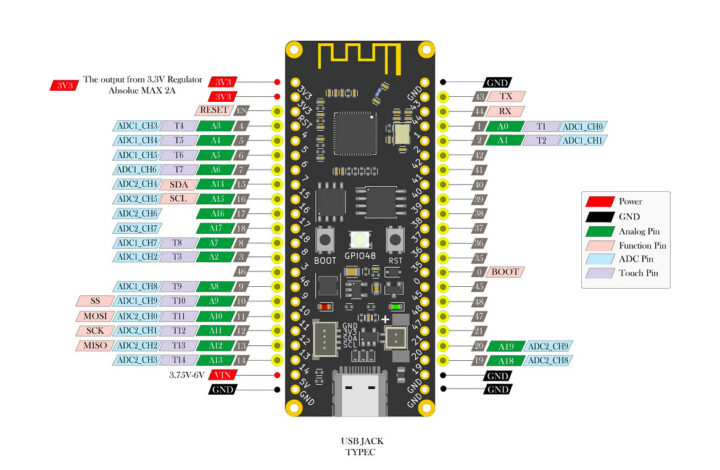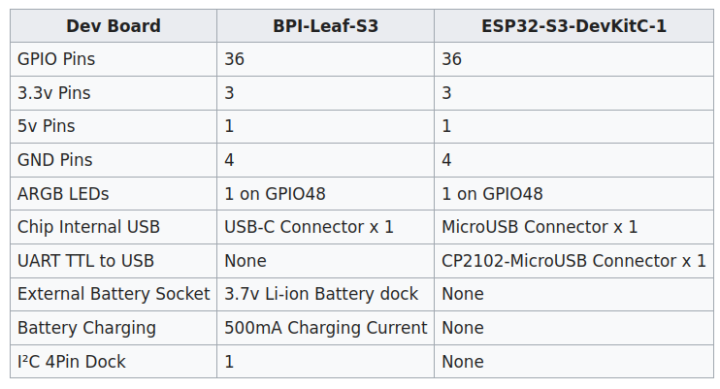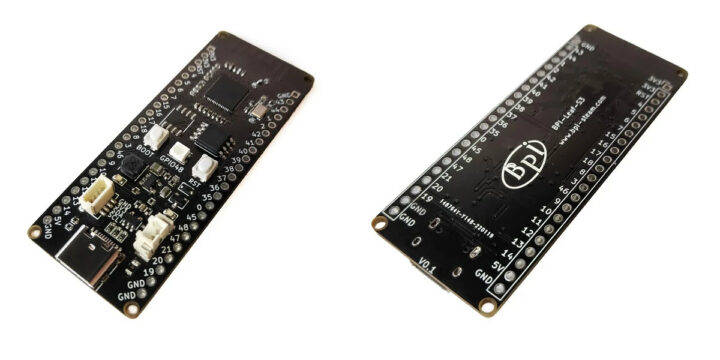Banana Pi is better known for its Arm Linux boards, but the company’s Banana Pi BPI-Leaf-S3 board features Espressif ESP32-S3 dual-core WiFi & BLE AI processor, with compatibility with ESP32-S3-DevKitC-1 minus a built-in USB to TTL chip, and added support for battery and an I2C connector.
Banana Pi Leaf (BPI-Leaf-S3) specifications:
- Wireless MCU – Espressif Systems ESP32-S3 dual-core Tensilica LX7 @ up to 240 MHz with vector instructions for AI acceleration, 512KB RAM, wireless connectivity
- Storage/Memory – 8MB flash, 2MB SPRAM
- Connectivity via ESP32-S3
- 2.4 GHz 802.11 b/g/n Wi-Fi 4 with 40 MHz bandwidth support
- Bluetooth Low Energy (BLE) 5.0 and Mesh connectivity with long-range support, up to 2Mbps data rate.
- PCB antenna
- USB – 1x USB Type-C OTG port for power and programming
- Expansion
- 2x 22-pin headers with up to 36x GPIO, 2x 12-bit ADC, 14x touch sensor inputs, 4x SPI, 2x I2C, 2x I2S, LCD interface, DVP camera interface, 3x UART, 8x PWM, USB serial/JTAG, SD/MMC, etc…
- 4-pin connector with 3.3V, GND, and I2C
- Misc – Nexopixel RGB LED
- Power Supply
- 5V via USB-C port
- 2-pin connector for 3.7V LiPo battery with charging circuitry
- Power consumption as low as 10 uA
- Dimensions – 65.25 x 26 mm

The company provides basic instructions to get started with the Banana Pi Leaf-S3 board using the ESP-IDF framework, MicroPython, or the Arduino IDE, as well as more technical including PDF schematics on the Wiki. The development flow will mostly be the same as ESP32-S3-DevKitC-1 (e.g. select ESP32S3 Dev Module in the Arduino IDE), except for the programming step as a USB to TTL chip is not included, and you’d need to press and hold the BOOT button to enter bootloader mode.

The Banana Pi BPI-Leaf-S3 board is sold on Aliexpress for $7.5 plus shipping. That seems a little high for an ESP32 board, but it seems ESP32-S3 hardware commands a higher price, at least for now, if we look at other such boards on Aliexpress.

Jean-Luc started CNX Software in 2010 as a part-time endeavor, before quitting his job as a software engineering manager, and starting to write daily news, and reviews full time later in 2011.
Support CNX Software! Donate via cryptocurrencies, become a Patron on Patreon, or purchase goods on Amazon or Aliexpress





